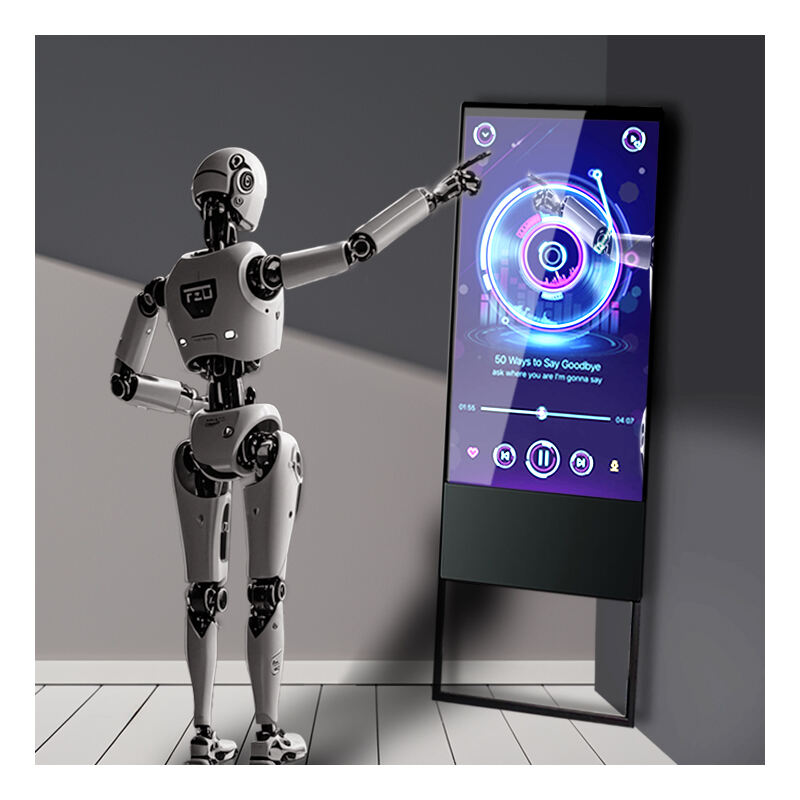SunKing Bath, יצרן מוביל עם יותר מ-30 שנה של נסיון בהפקת מראות, מציע מגוון רחב של מראות כולל מראות LED לבתי שימוש, מראות FITNESS, מראות באורך גוף ומראות חכמים.
הבית המודרני עובר שינוי מרשים, עם טכנולוגיה המשולבת באופן חלק בכל כדור של מרחב המגורים. בפרון של מהפכה זו עומד מראה אינטראקטיבי המראה האינטראקטיבי, שילוב מתקדם של השתקפות מסורתית וחדשנות דיגיטלית מתקדמת. ההתקנים המרשימים הללו התפתחו מפניות רפלקטיביות פשוטות והפכו למרכזי בית חכם עוצמתיים, המסוגלות להציג עדכוני מזג אוויר, פגישות יומן, ערוצי חדשות ואפילו מדדי כושר, תוך שמירה על הפונקציה הראשית שלהם כمراות.
בעודנו מגלים את הנוף המתפתח של טכנולוגיית הבית החכם, הבחירה בין מראה אינטראקטיבית לבין תצוגה חכמה קונבנציונלית הופכת להיות משמעותית יותר. לכל אפשרות יתרונות ייחודיים ומקרים שימוש ספציפיים שמתאימים לצרכים והעדפות שונות של אורח חיים. הבנת ההבדלים האלה היא קריטית לשם קבלת החלטה מושכלת לגבי הטכנולוגיה שתשרת בצורה הטובה ביותר את מערכת הבית החכם שלך.
מראה אינטראקטיבי משלב בין מראה מסורתי לטכנולוגיית תצוגה מתקדמת, ומייצר משטח דו-מטרתי שממשתף פעולה הן כמראה מחזירה והן ממשטח דיגיטלי. הטכנולוגיה מבוססת על טיפולים מיוחדים של זכוכית ועל מסכי תצוגה הממוקמים בצורה אסטרטגית והופכים לגלויים רק כאשר הם מופעלים, וכך שומרים על היופי האסתטי של המראה כאשר היא לא פעילה.
המערכת כוללת בדרך כלל בקרים רגישים למגע, יכולות זיהוי קול וחיישנים שונים המאפשרים אינטראקציה חלקה. מעבדים מובנים מנהלים יישומים ותכונות מרובים, בעוד שמודולי החיבור מאפשרים אינטגרציה עם מכשירי בית חכמים ושירותי אינטרנט אחרים.
מראזים אינטראקטיביים מודרניים מציעים מגוון מרשים של תכונות שעוברות בהרבה על ריפlection בסיסי. משתמשים יכולים לגשת לחיזוי מזג אוויר אישי, עדכוני תנועה ודפי חדשות בזמן שהם מתכוננים ליום. חובבי כושר מעריכים את היכולת לעקוב אחר תוכניות אימונים, לעקוב אחר סטטיסטיקות חיוניות ולניטור התקדמות באמצעות יישומי בריאות משולבים.
יכולות בקרת בית חכם מאפשרות למשתמשים להתאים את התאורה, הטמפרטורה ומערכות האבטחה ישירות ממשטח המראה. דגמים מסוימים אפילו כוללים עוזרים מבוססי בינה מלאכותית שיכולים לספק המלצות מותאמות אישית, ניהול לוחות זמנים ופונקציונליות בשליטת קול.
תצוגות חכמות הן מסכיים שנועדו במיוחד לצריכת תוכן דיגיטלי ולשליטה בבית חכם. מכשירים אלו לרוב כוללים מסכיים בעלי רזולוציה גבוהה, המותאמים לאיכות התאורה ולזוויות תצוגה, מה שהופך אותם אידיאליים להצגת מידע ייעודי ושידור מולטימדיה.
בניגוד למראות אינטראקטיביים, תצוגות חכמות אינן משמשות למטרה כפולה וניתנות לזיהוי מיידי כמכשירי טכנולוגיה. העיצוב שלהן מתמקד במקסום שטח המסך ובסיפוק בקרות מישוש אינטואיטיביות, לעתים קרובות תוך שילוב רמקולים ומיקרופונים באיכות גבוהה לצורך חווית מולטימדיה משופרת.
תצוגות חכמות מצטיינות ביכולתן להתמזג עם מערכות בית חכם קיימות. לעתים קרובות הן משמשות כמרכז בקרה מרכזי להפעלת מכשירים מחוברים שונים ומציעות לרוב תאימות רחבה יותר ליישומים ושירותים של צד ג' . האופי הייעודי של המכשירים האלה מאפשר עדכוני תוכנה פשוטים יותר והוספת תכונות בקלות רבה יותר.
למרבה מסכי חכם יש תמיכות פרופילי משתמשים מרובים וניתן להעבירם בקלות בין החדרים, מה שמאפשר גמישות במיקום ובתרחישי שימוש. עם זאת, אין בהם את האינטגרציה האסתטית ההדוקה שמספקים מראות אינטראקטיביות במרחבים כמו חדרי רחצה ואזורים לאיפור.
مراות אינטראקטיביות בולטות במרחבים שבהם יש צורך בשילוב הרמוני בין אסתטיקה לפונקציונליות. הן מצטיינות בחדרי רחצה, באולמות הלבשה ובכניסות, שם התכלית הכפולה שלהן מספקת ערך מעשי תוך שמירה על מראה מתקדם. היכולת לשלב את המראה בסביבה כאשר אינו בשימוש הופכת אותה במיוחד למשיכה לבני בית בעלי חוש דesign.
צגים חכמים, למרות היותם גמישים יותר מבחינת מיקום, לעתים יכולים להרגיש לא במקום מסוימים. הם מתאימים יותר למקומות מיוחדים כמו מטבחים, סלונים או משרדים בבית, בהם נוכחותם כהתקן טכנולוגי היא רלוונטית בהקשר.
החוויה של המראה האינטראקטיבי ייחודית במיוחד לritos של בוקר וערב, ומאפשרת למשתמשים לגשת למידע בזמן ביצוע פעולות טיפוח יומיות. שילוב זה בצורה טבעית בתוך הרגלים קיימים יכול לגרום לטכנולוגיה להרגיש אינטואיטיבית יותר ולא מפריעה. צירוף של השתקפות ותוכן דיגיטלי יוצר שילוב חלק של תפקודיות מעשית ותכונות חכמות.
תצוגות חכמות מציעות חווית משתמש מסורתית יותר, שמתמקדת בהערתנות אקטיבית עם תוכן דיגיטלי. הן מצטיינות בסיטואציות הדורשות תשומת לב מיוחסת, כגון עוקבות אחר מתכון, ביצוע שיחי וידאו או בקרה של מכשירי בית חכם. המחיר הוא שהן דורשות אינטראקציה מכוונת יותר, ולא משתלבות באופן טבעי בתוך ריטואלים קיימים.

ראי אינטראקטיביים מייצגים בדרך כלל השקעה ראשונית גבוהה יותר בשל הבנייה המתקדמת שלהם והפונקציונליות הכפולה. עם זאת, האינטגרציה שלהם בתצורי הבית והפוטנציאל להגביר את ערך הנכס עלולים להצדיק את המחירים הגבוהים. עמידותם של הרואי וטבעם הקלאסי תורמים גם הם לערך ארוך הטווח שהם מציעים.
תצוגות חכמות מגיעות בדרך כלל במחיר נמוך יותר ועשויות להציע עדכונים והחלפות תכופים יותר של החומרה. בעוד שזה עלול לאפשר גישה לתכונות חדשות באופן קבוע, זה גם עלול להוביל לעלות מצטברות גבוהות יותר לאורך זמן אם עדכנייה עם הטכנולוגיה היא בעלת עדיפות גבוהה.
התקנת מראה אינטראקטיבי דורשת לעיתים קרובות סיוע מקצועי, במיוחד בדגמים גדולים או כאלו עם תכונות מתקדמות הדורשות חיבור חשמל וחיבור רשת. שיקולי תחזוקה כוללים ניקוי תקופתי של משטח המראה ודאגה לבידוד מתאים של הרכיבים האלקטרוניים.
תצוגות חכמות מציעות תהליכי התקנה פשוטים יותר, שדורשים בדרך כלל רק שקע חשמל וחיבור Wi-Fi. צרכי התחזוקה שלהן מוגבלים בדרך כלל לניקוי בסיסי ולעדכוני תוכנה, מה שהופך אותן לנגישות יותר למשתמשים המעדיפים פתרון טען-והפעל.
מראזים אינטראקטיביים משתמשים בטכנולוגיית מראה דו-כיוונית מיוחדת בשילוב עם מסכי תצוגה הממוקמים בצורה אסטרטגית. כאשר המסך כבוי, המשטח פועל כמו מראה רגילה. כשנפעל, המסך הופך לגלוי דרך משטח המראה תוך שמירה על תכונות השיקוף באזורים הסמוכים.
מרבית המראות האינטראקטיביים תומכים בפרופילים של מספר משתמשים, מה שמאפשר לembros שונים של המשפחה לגשת לתוכן, הגדרות והעדפות אישיים. טכנולוגיית זיהוי פנים בדגם מסוימים יכולה להטעין באופן אוטומטי את הפרופיל המתאים כאשר משתמש מתקרב אל המראה.
מרחיבים אינטראקטיביים דורשים בדרך כלל התקנה קבועה ועשויים לצרוך יותר חשמל בשל גודלם הגדול ושילוב הפונקציות. מסכי 스מארט הם יעילים יותר מבחינת צריכה חשמלית ויכולים לרוב לפעול עם שקע חשמל סטנדרטי, מה שנותן גמישות רבה יותר מבחינת מיקום וניהול חשמל.
מסכי 스מארט מקבלים בדרך כלל עדכונים תכופים יותר של תוכנה ויש להם תאימות רחבה יותר לאפליקציות בזכות הפלטפורמות הסטנדרטיות שלהם. לmerחיבים אינטראקטיביים עשוית להיות סביבות תוכנה מיוחדות יותר, אך לעתים קרובות הם מתמקדים בפונקציונליות בסיסית שנשארת יציבה ואמינה לאורך זמן.